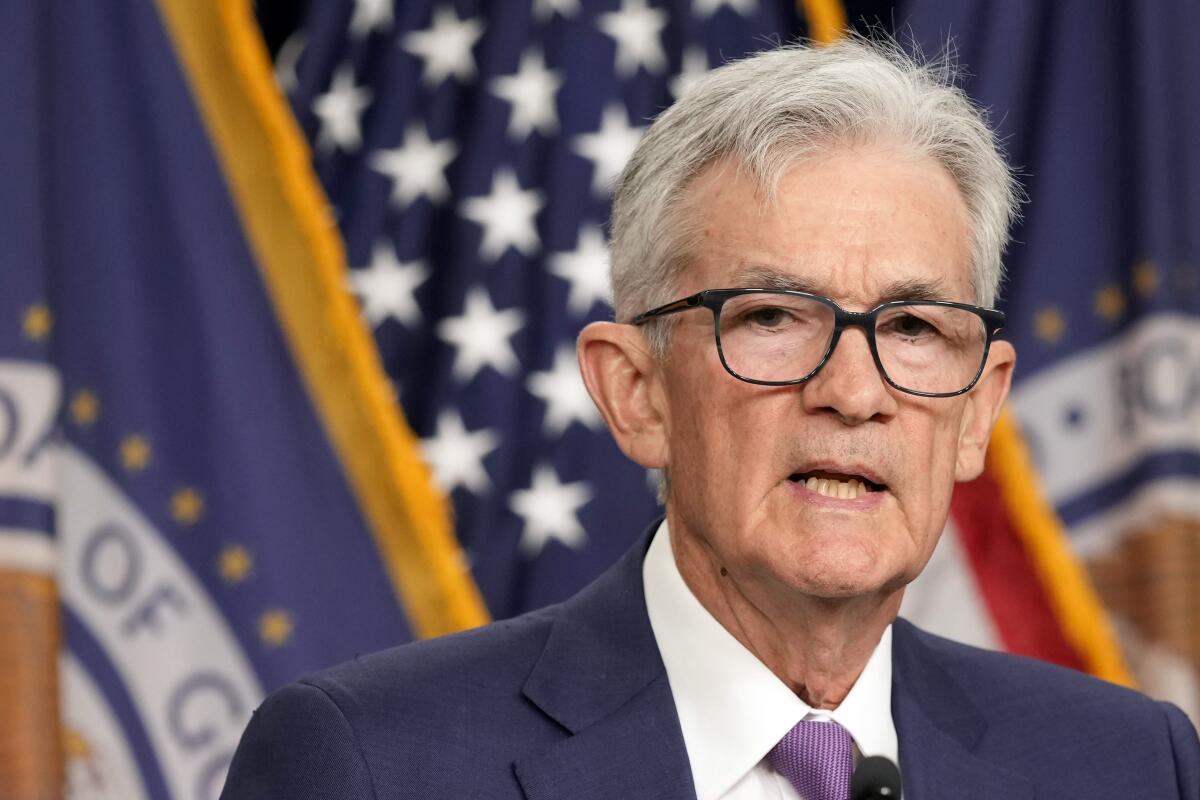Fed cuts interest rates again, but Trump’s victory makes future path much murkier

- Share via
The Federal Reserve cut interest rates for a second straight time Thursday in an effort to keep the economy sailing along by easing the high borrowing costs it engineered to fight inflation. But going forward the Fed’s rate path looks very uncertain as policymakers must contend with a big new unknown: the policies and politics of a second Trump presidential term.
Thursday’s quarter-percentage-point reduction in the Fed’s benchmark rate was expected. It comes on the heels of a half-point cut in September, when the central bank pivoted to loosen monetary policy after having held its key rate at a two-decade high of 5.33% for months to throttle back inflation.
“The economy is strong overall,” said Jerome H. Powell, the Fed’s chair, at a news conference after a two-day meeting. “The labor market has cooled from its formerly overheated state and remains solid. Inflation has eased substantially.”
Although inflation remains a bit higher than the Fed’s 2% target, prices have come down sharply from their highs in 2022. Fed officials had previously signaled Thursday’s rate cut and another one in December, followed by several more next year.
The Fed eventually wants to get to a point where interest rates are neither stimulating nor restricting the economy, as they are now. That’s seen as happening with a rate of about 3%.
“We’re trying to steer between the risk of moving too quickly and perhaps undermining our progress on inflation or moving too slowly and allowing the labor market to weaken too much,” Powell said. “We’re trying to be on a middle path where we can maintain the strength in the labor market while also enabling further progress on inflation.”
But with Trump’s victory, the Fed’s balancing act may get a lot harder.
Economists see risks on two fronts: If Trump follows through on his campaign promises to lower taxes, levy across-the-board tariffs on foreign goods and undertake mass deportations, thereby shrinking the labor supply, he could spur economic growth but also reignite inflation in the process, forcing the Fed to pull back on its rate-cutting plans.
The prospect of stronger growth, especially for corporations, was largely behind the huge rally on Wall Street after Trump’s sweeping win. The Dow, which surged more than 1,500 points Wednesday, or up 3.6%, closed unchanged. The broader Standard & Poor’s 500 index extended its gains, rising 0.74%; and the Nasdaq climbed 1.5%.
But even as the Fed has lowered rates, mortgage rates have edged a bit higher recently, along with long-term bond yields, reflecting what some see as expectations for higher inflation and interest rates down the road. If that trend continues, it could further complicate Fed decisions, especially because housing costs seem to be a top concern for people.
“The rise in long-term rates and mortgages is kind of offsetting some of the oomph of the Fed’s rate cuts,” said Ryan Sweet, chief U.S. economist at Oxford Economics.
“We’re watching that,” Powell said when asked about higher long-term bond yields, which move in tandem with mortgage rates. But, he added, “it’s too early to say where they settle. If they’re persistent and they’re material, we’ll certainly take them into account.”
The second risk is the politics of a reelected president who has often challenged the traditional independence of the central bank and the mainstream economics of Powell.
In Trump’s first term, he at times publicly hectored Powell and his advisors pushed him to resign, though it was Trump who appointed him. The Fed and financial markets consider the central bank’s independence sacrosanct for sound economic policymaking.
Without commenting on Trump, Rodney Ramcharan, a former Fed economist who is now professor of finance and business economics at USC’s Marshall School of Business, said that “a feature of authoritarian governments is an erosion of norms and institutions.” And he noted that political pressure could be applied in public or privately.
“He likes low interest rates,” Christopher Rupkey, chief economist at Fwdbonds, an economic and market research firm in New York, said of Trump. “There could be more jawboning to get rates lower and to get stronger growth.”
And if he doesn’t get what he wants, Rupkey said, Trump could replace Powell when his term expires in May 2026. “One of the wild card factors is, he gets someone in there that would be amenable to pushing rates even lower.”
Powell has long insisted that the Fed makes its decision without consideration of politics. Asked on Thursday whether he would resign if president-elect Trump asked him to, Powell replied, “No.”
For now, analysts expect the Fed to stay on its rate-cutting course, shaving another quarter of a percentage point from its main interest rate at its December meeting.
But since Trump’s sweeping victory, odds have increased that Fed officials will pause next month or early next year as they wait to see what a second Trump administration might mean for fiscal policies and the economy.
Powell said that the Fed’s decisions will continue to be data driven and that it’s too early to say how the economy might evolve.
“In the near term, the election will have no effects on our policy decisions,” he said. “Here, we don’t know what the timing and substance of any policy changes will be. We therefore don’t know what the effects on the economy will be, specifically whether and to what extent those policies would matter in the achievement for our goal variables, maximum employment and price stability.
“We don’t guess, we don’t speculate and we don’t assume,” he said.
More to Read
Inside the business of entertainment
The Wide Shot brings you news, analysis and insights on everything from streaming wars to production — and what it all means for the future.
You may occasionally receive promotional content from the Los Angeles Times.











